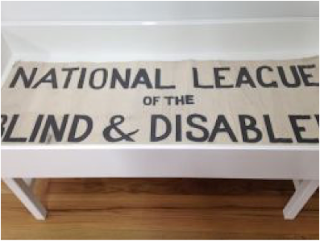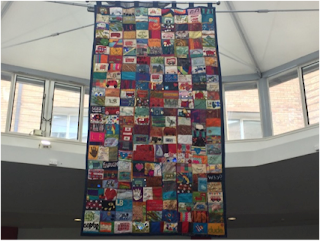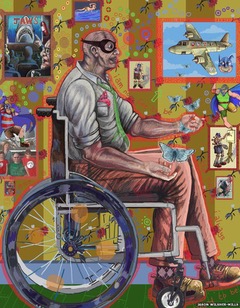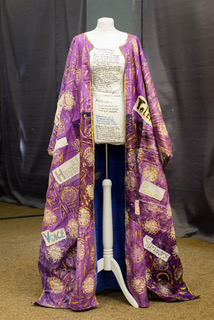By Paul van Trigt1
In a recent tweet a psychologist was asking professionals and families to help clients with an intellectual disability to report to the committee of the Dutch government that investigates violence against youth in the postwar period.2 The person that drew my attention to this tweet was critical: should the psychologist not ask the committee to communicate in a more effective and accessible way? And do people with intellectual disabilities really need help to report? This example shows in a nutshell the problematic position of persons with disabilities in the current investigation of violence against youth with a disability in the postwar Netherlands: the research seems – at least partly - to happen ‘about us, without us’. In this blog, I do not want to evaluate the still ongoing Dutch research, but to share some general considerations that transcend the Dutch case and that are hopefully relevant when it comes to dealing with the growing attention nowadays for violence against marginalized groups including people with disabilities in the past.
I want to take my starting point in what Cathy Kudlick wrote a couple of years ago, namely that disability history ‘will always come back to two core political ideas, both rooted in the disability rights movement: a need to challenge the prevailing assumptions about disability, and the importance of granting people with disabilities historical agency’. Kudlick’s statement challenges the current approach to violence against and abuse of people with disabilities in the past with the argument, that research about violence does not automatically undermine prevailing assumptions about disability or takes the voice of people with disabilities seriously. The following question can therefore be asked: does historical research of violence serve the emancipation of people with disabilities? I have no clear-cut answer to the question, but I think the following issues have to be considered.
In the first place, the attention to violence against people with disabilities in the last decades is part of a broader interest in violence against marginalized groups in the past. Historians like François Hartog increasingly tend to interpret this new interest in violent pasts as part of what they call a ‘new time regime’. The hypothesis is that the fall of the Berlin Wall and the end of the Cold War marked the end of the so-called modern time regime in which present and past were seen in terms of the future. The new regime that became dominant since then, subordinates the past and future to the present: ‘while the future has lost much of its luminosity, the past has more and more invaded our consciousness’. Especially ‘traumatic pasts’ like the history of slavery receive increasingly attention in (Western) societies and are approached with current standards like human rights, from postcolonial perspectives and from the viewpoint of ‘victims’.3 The new time regime is however not evitable. Whereas John Torpey argues that the changing time regime has replaced the ‘traditional rallying cry of historical militant labour – “don’t mourn, organize”’ by ‘organize to mourn’, Berber Bevernage has shown in the context of transitional justice that the future still can be leading: ‘the political function of the truth commission is first and foremost directed at managing a break with the past’. Torpey is thus critical about the disappearing visions of the future, but Bevernage asks if the vision of the future of truth commissions and their ‘turn to history in order to pacify the past may not also come at the cost of memory and justice’.4 So, I would suggest that it is not self-evident that the investigations as initiated by the government serve the emancipation of people with disabilities and that, at least, in every specific context reflection on this by different stakeholders is needed.
Related to that, my second consideration is in particular directed to historians: their professional practice did namely not necessarily serve the victims or survivors. Historians (including myself) namely unconsciously often follow a modern time regime in which they see it as their task to ‘historicize’, to recognize the characteristics of every era and to make distinctions between era’s and consequently between the present and the past. As argued by Bevernage, these distinctions are not set in stone and object of debate and negotiation. When it comes to historical injustice, historicizing can be helpful but also dangerous: it can be misused to close the past too early and even to legitimize impunity.5 Historians have to be aware of this. Moreover, scientific-historical research usually presumes a distance between the historian in the present and his object in the past. Piet de Rooy has pointed out in his response to the research report about abuse in the Dutch Catholic institutions, that historical research should be directed by analysis, not by condemnation. Therefore one could ask if historians are capable of giving recognition, let alone ‘full satisfaction to traumatised victims’?6
My third and last consideration is that research about violence in the past makes clear that the perspective of the survivors of violence, to put it kindly, not always is taken into account.7 Survivors were often not approached as ‘genuine partners in conversation’, as Henry Greenspan has argued for, but as passive victims.8 Here is a form of inequality at work, of which scholars today become increasingly aware - as can for example be illustrated by a quote of anthropologist Joel Robbens: ‘it has often been the suffering subject who replaced the savage one as a privileged object of our attention’.9 Research about (sexual) violence in institutions in the past, despite good intentions, runs the risk to (re)present people with disabilities only as suffering subjects, or even suffering objects. Therefore, the insights of (new) disability historians are more than ever needed to complicate the results of such research. Rosemary Garland-Thomson for instance, has developed a helpful ‘taxonomy of four primary visual rhetorics of disability’.10 She makes a distinction between wondrous, sentimental, exotic, and realistic images that complicates a restrictive terminology as being either positive or negative. In particular relevant seems the alternative and by Walter Benjamin inspired conceptualization of time as proposed by Verstraete, who has argued that disability history cannot be understood as ‘a steady and linear progression’: ‘even the best intended solutions might have some less desirable side-effects that were not foreseen’.11 This sounds perhaps as a pessimistic note to end with, but that is not necessarily the case. In this understanding of time is not only recognized that human possibilities are limited, but also that bad things can turn to the better. In my current research, consisting of making a genealogy of the CRPD, I see a lot of paternalistic humanitarianism in the disability policies at the UN level, but in the course of time people with disabilities became more and more subjects and agents of international law. So, hopefully the ‘storm blowing from paradise’ (Benjamin) makes the current attention to disabled pasts into something that serves the emancipation of people with disabilities in present and future.
About the author:
Paul van Trigt is postdoctoral researcher in the ERC-project Rethinking Disability: the Impact of the International Year of Disabled Persons (1981) in Global Perspective at the Institute of History, Leiden University (www.rethinkingdisability.net). He has published about the modern history of the welfare state, human rights, disability and religion. His monograph Blind in een gidsland (Blind in a guiding country) was published in 2013, he also edited and contributed to a special issue of the journal Social Inclusion about disability and ‘being human’ (https://www.cogitatiopress.com/socialinclusion/issue/view/54).
References:
1 I want to thank the editors and Corrie Tijsseling for their comments on an earlier version of the blog text. ↩
2 See for information about the Dutch investigations: https://www.commissiegeweldjeugdzorg.nl ↩
3 Aleida Assmann, ‘Transformations of the Modern Time Regime’, in: Chris Lorenz (eds), Breaking up time: negotiating the borders between present, past and future (Göttingen 2013) 39-56: 41. Digital available here: https://pdfs.semanticscholar.org/36b1/ac544a01bae663f57d9d16087fd7a6e9f74c.pdf ↩
4 Berber Bevernage, ‘Writing the Past Out of the Present: History and the Politics of Time in Transitional Justice’, History Workshop Journal 69 (2010) 111-131: 118 and 125. ↩
5 Bevernage, ‘”Always historicize.” Over de ethische en politieke implicaties van een “historische” houding in de context van waarheids- en historische commissies’, Groniek 194 (2013) 17-36. Digital available here: https://biblio.ugent.be/publication/5765496/file/5910517.pdf ↩
6 Piet de Rooy, ‘Verklaren en veroordelen. Enige opmerkingen over recent onderzoek naar seksueel misbruik’, BMGN-Low Countries Historical Review 129, 1 (2014) 77-87. Digital available: https://www.bmgn-lchr.nl/articles/abstract/10.18352/bmgn-lchr.9447 ↩
7 Henry Greenspan, ‘Afterword’, in: Steven High (ed.), Beyond Testimony and Trauma. Oral History in the Aftermath of Mass Violence (Vancouver Toronto 2015) 351-356: 351. ↩
8 Quoted by Sten High, ‘Introduction’, in: idem, Beyond Testimony, 3-28: 15. ↩
9 Joel Robbins, ‘Beyond the suffering subject: toward an anthropology of the good’, Journal of the Royal Anthropological Institute 19 (2013) 447-462: 450. ↩
10 Rosemary Garland-Thomson, ‘The Politics of Staring: Visual Rhetorics of Disability in Popular Photography’, in: Sharon L. Snyder (ed.) Disability Studies: Enabling the Humanities (New York 2002) 56-75. Digital available here: http://thowe.pbworks.com/f/politics.of.staring.pdf ↩
11 Pieter Verstraete, In the shadow of disability. Reconnecting History, Identity and Politics (Opladen Berlin Toronto 2012) 52-54. Cf. Sebastian Barsch, Anne Klein and Pieter Verstraete, ‘The need for imperfection. Disability histories in Europe’, in: idem (eds.), The imperfect Historian. Disability Histories in Europe (Frankfurt am Main 2013) 7-13. ↩
Recommended Citation:
Paul van Trigt (2018): Emancipation and violence against people with disabilities in the past. In: Public Disability History 3 (2018) 5.
In a recent tweet a psychologist was asking professionals and families to help clients with an intellectual disability to report to the committee of the Dutch government that investigates violence against youth in the postwar period.2 The person that drew my attention to this tweet was critical: should the psychologist not ask the committee to communicate in a more effective and accessible way? And do people with intellectual disabilities really need help to report? This example shows in a nutshell the problematic position of persons with disabilities in the current investigation of violence against youth with a disability in the postwar Netherlands: the research seems – at least partly - to happen ‘about us, without us’. In this blog, I do not want to evaluate the still ongoing Dutch research, but to share some general considerations that transcend the Dutch case and that are hopefully relevant when it comes to dealing with the growing attention nowadays for violence against marginalized groups including people with disabilities in the past.
I want to take my starting point in what Cathy Kudlick wrote a couple of years ago, namely that disability history ‘will always come back to two core political ideas, both rooted in the disability rights movement: a need to challenge the prevailing assumptions about disability, and the importance of granting people with disabilities historical agency’. Kudlick’s statement challenges the current approach to violence against and abuse of people with disabilities in the past with the argument, that research about violence does not automatically undermine prevailing assumptions about disability or takes the voice of people with disabilities seriously. The following question can therefore be asked: does historical research of violence serve the emancipation of people with disabilities? I have no clear-cut answer to the question, but I think the following issues have to be considered.
In the first place, the attention to violence against people with disabilities in the last decades is part of a broader interest in violence against marginalized groups in the past. Historians like François Hartog increasingly tend to interpret this new interest in violent pasts as part of what they call a ‘new time regime’. The hypothesis is that the fall of the Berlin Wall and the end of the Cold War marked the end of the so-called modern time regime in which present and past were seen in terms of the future. The new regime that became dominant since then, subordinates the past and future to the present: ‘while the future has lost much of its luminosity, the past has more and more invaded our consciousness’. Especially ‘traumatic pasts’ like the history of slavery receive increasingly attention in (Western) societies and are approached with current standards like human rights, from postcolonial perspectives and from the viewpoint of ‘victims’.3 The new time regime is however not evitable. Whereas John Torpey argues that the changing time regime has replaced the ‘traditional rallying cry of historical militant labour – “don’t mourn, organize”’ by ‘organize to mourn’, Berber Bevernage has shown in the context of transitional justice that the future still can be leading: ‘the political function of the truth commission is first and foremost directed at managing a break with the past’. Torpey is thus critical about the disappearing visions of the future, but Bevernage asks if the vision of the future of truth commissions and their ‘turn to history in order to pacify the past may not also come at the cost of memory and justice’.4 So, I would suggest that it is not self-evident that the investigations as initiated by the government serve the emancipation of people with disabilities and that, at least, in every specific context reflection on this by different stakeholders is needed.
Related to that, my second consideration is in particular directed to historians: their professional practice did namely not necessarily serve the victims or survivors. Historians (including myself) namely unconsciously often follow a modern time regime in which they see it as their task to ‘historicize’, to recognize the characteristics of every era and to make distinctions between era’s and consequently between the present and the past. As argued by Bevernage, these distinctions are not set in stone and object of debate and negotiation. When it comes to historical injustice, historicizing can be helpful but also dangerous: it can be misused to close the past too early and even to legitimize impunity.5 Historians have to be aware of this. Moreover, scientific-historical research usually presumes a distance between the historian in the present and his object in the past. Piet de Rooy has pointed out in his response to the research report about abuse in the Dutch Catholic institutions, that historical research should be directed by analysis, not by condemnation. Therefore one could ask if historians are capable of giving recognition, let alone ‘full satisfaction to traumatised victims’?6
My third and last consideration is that research about violence in the past makes clear that the perspective of the survivors of violence, to put it kindly, not always is taken into account.7 Survivors were often not approached as ‘genuine partners in conversation’, as Henry Greenspan has argued for, but as passive victims.8 Here is a form of inequality at work, of which scholars today become increasingly aware - as can for example be illustrated by a quote of anthropologist Joel Robbens: ‘it has often been the suffering subject who replaced the savage one as a privileged object of our attention’.9 Research about (sexual) violence in institutions in the past, despite good intentions, runs the risk to (re)present people with disabilities only as suffering subjects, or even suffering objects. Therefore, the insights of (new) disability historians are more than ever needed to complicate the results of such research. Rosemary Garland-Thomson for instance, has developed a helpful ‘taxonomy of four primary visual rhetorics of disability’.10 She makes a distinction between wondrous, sentimental, exotic, and realistic images that complicates a restrictive terminology as being either positive or negative. In particular relevant seems the alternative and by Walter Benjamin inspired conceptualization of time as proposed by Verstraete, who has argued that disability history cannot be understood as ‘a steady and linear progression’: ‘even the best intended solutions might have some less desirable side-effects that were not foreseen’.11 This sounds perhaps as a pessimistic note to end with, but that is not necessarily the case. In this understanding of time is not only recognized that human possibilities are limited, but also that bad things can turn to the better. In my current research, consisting of making a genealogy of the CRPD, I see a lot of paternalistic humanitarianism in the disability policies at the UN level, but in the course of time people with disabilities became more and more subjects and agents of international law. So, hopefully the ‘storm blowing from paradise’ (Benjamin) makes the current attention to disabled pasts into something that serves the emancipation of people with disabilities in present and future.
About the author:
Paul van Trigt is postdoctoral researcher in the ERC-project Rethinking Disability: the Impact of the International Year of Disabled Persons (1981) in Global Perspective at the Institute of History, Leiden University (www.rethinkingdisability.net). He has published about the modern history of the welfare state, human rights, disability and religion. His monograph Blind in een gidsland (Blind in a guiding country) was published in 2013, he also edited and contributed to a special issue of the journal Social Inclusion about disability and ‘being human’ (https://www.cogitatiopress.com/socialinclusion/issue/view/54).
References:
1 I want to thank the editors and Corrie Tijsseling for their comments on an earlier version of the blog text. ↩
2 See for information about the Dutch investigations: https://www.commissiegeweldjeugdzorg.nl ↩
3 Aleida Assmann, ‘Transformations of the Modern Time Regime’, in: Chris Lorenz (eds), Breaking up time: negotiating the borders between present, past and future (Göttingen 2013) 39-56: 41. Digital available here: https://pdfs.semanticscholar.org/36b1/ac544a01bae663f57d9d16087fd7a6e9f74c.pdf ↩
4 Berber Bevernage, ‘Writing the Past Out of the Present: History and the Politics of Time in Transitional Justice’, History Workshop Journal 69 (2010) 111-131: 118 and 125. ↩
5 Bevernage, ‘”Always historicize.” Over de ethische en politieke implicaties van een “historische” houding in de context van waarheids- en historische commissies’, Groniek 194 (2013) 17-36. Digital available here: https://biblio.ugent.be/publication/5765496/file/5910517.pdf ↩
6 Piet de Rooy, ‘Verklaren en veroordelen. Enige opmerkingen over recent onderzoek naar seksueel misbruik’, BMGN-Low Countries Historical Review 129, 1 (2014) 77-87. Digital available: https://www.bmgn-lchr.nl/articles/abstract/10.18352/bmgn-lchr.9447 ↩
7 Henry Greenspan, ‘Afterword’, in: Steven High (ed.), Beyond Testimony and Trauma. Oral History in the Aftermath of Mass Violence (Vancouver Toronto 2015) 351-356: 351. ↩
8 Quoted by Sten High, ‘Introduction’, in: idem, Beyond Testimony, 3-28: 15. ↩
9 Joel Robbins, ‘Beyond the suffering subject: toward an anthropology of the good’, Journal of the Royal Anthropological Institute 19 (2013) 447-462: 450. ↩
10 Rosemary Garland-Thomson, ‘The Politics of Staring: Visual Rhetorics of Disability in Popular Photography’, in: Sharon L. Snyder (ed.) Disability Studies: Enabling the Humanities (New York 2002) 56-75. Digital available here: http://thowe.pbworks.com/f/politics.of.staring.pdf ↩
11 Pieter Verstraete, In the shadow of disability. Reconnecting History, Identity and Politics (Opladen Berlin Toronto 2012) 52-54. Cf. Sebastian Barsch, Anne Klein and Pieter Verstraete, ‘The need for imperfection. Disability histories in Europe’, in: idem (eds.), The imperfect Historian. Disability Histories in Europe (Frankfurt am Main 2013) 7-13. ↩
Recommended Citation:
Paul van Trigt (2018): Emancipation and violence against people with disabilities in the past. In: Public Disability History 3 (2018) 5.











